| F-35 Lightning II | |
|---|---|
| An F-35A Lightning II, marked AA-1, lands at Edwards Air Force Base, California | |
| Role | Stealth multirole fighter |
| National origin | United States |
| Manufacturer | Lockheed Martin Aeronautics |
| First flight | 15 December 2006[1] |
| Introduction | 2016[2][3] |
| Status | In limited production, undergoing flight testing |
| Produced | 2006–present |
| Number built | 13 flight-test aircraft; [N 1] |
| Unit cost | US$110 million (average per unit cost for F-35A in LRIP-9, FY2016)[6] |
| Developed from | Lockheed Martin X-35 |
The F-35 is descended from the X-35, the product of the Joint Strike Fighter (JSF) program. JSF development is being principally funded by the United States, with the United Kingdom and other partner governments providing additional funding. It is being designed and built by an aerospace industry team led by Lockheed Martin.[9] The F-35 took its first flight on 15 December 2006.[1]
The United States intends to buy a total of 2,443 aircraft for an estimated US$323 billion, making it the most expensive defense program ever.[10] The United States Air Force (USAF) budget data in 2010, along with other sources, projects the F-35 to have a flyaway cost that ranges between US$89 million and US$200 million over the planned production of F-35s, depending on the variant.[11][12][13][14] Cost estimates have risen to $382 billion for 2,443 aircraft, at an average of $92 million each. However, rising program cost estimates have cast doubt on the actual number to be produced for the U.S. In January 2011 Defense Secretary Robert Gates expressed the Pentagon's frustration with the skyrocketing costs of the F-35 program when he said "The culture of endless money that has taken hold must be replaced by a culture of restraint." Focusing his attention on the troubled VTOL F-35B Gates ordered "a two-year probation", saying it "should be canceled" if corrections are unsuccessful.[15]
Certain private analysts claim that the whole F-35 program is becoming a money pit. "The incredibly unfortunate phrase 'too big to fail' applies to this aircraft more than any other defense program", said Richard Aboulafia, an aerospace industry analyst with the Teal Group.[15]
Contents
|
Development
JSF Program requirements and selection
Main article: Joint Strike Fighter Program
The JSF program was designed to replace the United States military F-16, A-10, F/A-18 (excluding newer E/F "Super Hornet" variants) and AV-8B tactical fighter aircraft. To keep development, production, and operating costs down, a common design was planned in three variants that share 80 percent of their parts:- F-35A, conventional take off and landing (CTOL) variant.
- F-35B, short-take off and vertical-landing (STOVL) variant.
- F-35C, carrier-based CATOBAR (CV) variant.

An F-35 wind tunnel testing model in the Arnold Engineering Development Center's 16-foot transonic wind tunnel
While the actual JSF development contract was signed on 16 November 1996, the contract for System Development and Demonstration (SDD) was awarded on 26 October 2001 to Lockheed Martin, whose X-35 beat the Boeing X-32. Although both aircraft met or exceeded requirements, the X-35 design was considered to have less risk and more growth potential.[17] The designation of the new fighter as "F-35" is out-of-sequence with standard DoD aircraft numbering,[18] by which it should have been "F-24". It came as a surprise even to Lockheed, which had been referring to the aircraft in-house by this expected designation.[19]
Design phase
F-35 Lightning II USAF video
The F-35B STOVL variant was in danger of missing performance requirements in 2004 because it weighed too much – reportedly, by 2,200 pounds (1,000 kg) or 8 percent. In response, Lockheed Martin added engine thrust and thinned airframe members; reduced the size of the common weapons bay and vertical stabilizers; re-routed some thrust from the roll-post outlets to the main nozzle; and redesigned the wing-mate joint, portions of the electrical system, and the portion of the aircraft immediately behind the cockpit.[21] Many of the changes were applied to all three variants to maintain high levels of commonality. By September 2004, the weight reduction effort had reduced the aircraft's design weight by 2,700 pounds (1,200 kg).[22]
On 7 July 2006, the US Air Force officially announced the name of the F-35: Lightning II, in honor of Lockheed's World War II-era twin-prop P-38 Lightning and the Cold War-era jet, the English Electric Lightning.[23][24][25] English Electric Company's aircraft division was a predecessor of F-35 partner BAE Systems. Lightning II was also an early company name for its fighter that was later named F-22 Raptor.
On 19 December 2008, Lockheed Martin rolled out the first weight-optimized F-35A (designated AF-1). It is the first F-35 to be produced at a full-rate production speed and is structurally identical to the production F-35As that will be delivered starting in 2010.[26]
As of 5 January 2009, six F-35s were complete, including AF-1 and AG-1, and 17 were in production. "Thirteen of the 17 in production are pre-production test aircraft, and all of those will be finished in 2009," said John R. Kent, acting manager of F-35 Lightning II Communications at Lockheed Martin Aeronautics Company. "The other four are the first production-model planes, and the first of those will be delivered in 2010 to the U.S. Air Force, and will go to Eglin Air Force Base."[27] On 6 April 2009, US Secretary of Defense Robert Gates proposed speeding up production for the US to buy 2,443 F-35s.[28]
In August 2010, Lockheed Martin announced delays in resolving a "wing-at-mate overlap" production problem, which would slow initial production.[29]
Program cost increases and further delays
On 21 April 2009, media reports, citing Pentagon sources, said that during 2007 and 2008, computer spies had managed to copy and siphon off several terabytes of data related to the F-35's design and electronics systems, potentially enabling the development of defense systems against the aircraft.[30] However, Lockheed Martin has rejected suggestions that the project has been compromised, saying that it "does not believe any classified information had been stolen".[31]On 9 November 2009, Ashton Carter, under-secretary of defense for acquisition, technology and logistics, acknowledged that the Pentagon "joint estimate team" (JET) had found possible future cost and schedule overruns in the project and that he would be holding meetings to attempt to avoid these.[32] On 1 February 2010, Gates removed JSF Program Manager U.S. Marine Major-General David Heinz and withheld $614 million in payments to Lockheed Martin because of program costs and delays.[33][34]
On 11 March 2010, a report from the Government Accountability Office to United States Senate Committee on Armed Services projected the overall unit cost of an F-35A to be $112M in today's money.[35] In 2010, Pentagon officials disclosed that the F-35 program has exceeded its original cost estimates by more than 50 percent.[36] An internal Pentagon report critical of the JSF project states that "affordability is no longer embraced as a core pillar". On 24 March, Gates termed the recent cost overruns and delays as "unacceptable" in a testimony before the U.S. Congress. He characterized previous cost and schedule estimates for the project as "overly rosy". However, Gates insisted the F-35 would become "the backbone of U.S. air combat for the next generation" and informed the Congress that he had expanded the development period by an additional 13 months and budgeted $3 billion more for the testing program while slowing down production.[37] Lockheed Martin expects to reduce government cost estimates by 20%.[38]
In November 2010 as part of a cost-cutting measure, the co-chairs of the National Commission on Fiscal Responsibility and Reform suggested canceling procurement of the F-35B and halving orders of F-35As and F-35Cs.[39][40][41] At the same time Air Force Magazine reported that "Pentagon officials" are considering canceling the F-35B because its short range means that the bases or ships it operates from will be within range of hostile tactical ballistic missiles.[42] However Lockheed Martin consultant Loren B. Thompson said that this rumor is merely a result of the usual tensions between the US Navy and Marine Corps, and there is no alternative to the F-35B as an AV-8B replacement.[43] He also confirmed that there would be further delays and cost increases in the development process because of technical problems with the aircraft and software, but blamed most of the delays and extra costs on redundant flight test.[44][45]
The Center for Defense Information estimated that the program would be restructured with an additional year of delay and $5 billion in additional costs.[46] On 5 November 2010, the Block 1 software flew for the first time on BF-4 which included information fusion and initial weapons-release capability.[47] As of the end of 2010, only 15% of the software remains to be written, but this includes the most difficult sections such as data fusion.[48] But in 2011 it was revealed that only 50% of the eight million lines of code had actually been written and that it would take another six years and 110 additional software engineers in order to complete the software for this new schedule.[49]
Former Pentagon manager Paul Kaminski has said that the lack of a complete test plan has added five years to the JSF program.[50]
As of February 2011, the main flaws with the aircraft are engine "screech", transonic wing roll-off and display flaws in the helmet mounted display.[51]
Design
The F-35 appears to be a smaller, slightly more conventional, single-engine sibling of the sleeker, twin-engine F-22 Raptor, and indeed drew elements from it. The exhaust duct design was inspired by the General Dynamics Model 200 design, which was proposed for a 1972 supersonic VTOL fighter requirement for the Sea Control Ship.[52] For specialized development of the F-35B STOVL variant, Lockheed consulted with the Yakovlev Design Bureau, purchasing design data from their development of the Yakovlev Yak-141 "Freestyle".[53][54] Although several experimental designs have been built and tested since the 1960s including the Navy's unsuccessful Rockwell XFV-12, the F-35B is to be the first operational supersonic, STOVL stealth fighter.[55]The F-35 has a maximum speed of over Mach 1.6. With a maximum takeoff weight of 60,000 lb (27,000 kg),[N 2][57] the Lightning II is considerably heavier than the lightweight fighters it replaces. In empty and maximum gross weights, it more closely resembles the single-seat, single-engine Republic F-105 Thunderchief, which was the largest single-engine fighter of the Vietnam war era. However the F-35's modern engine delivers over 60 percent more thrust in an aircraft of the same weight so that in thrust to weight and wing loading it is much closer to a comparably equipped F-16.[N 3]
Acquisition deputy to the assistant secretary of the Air Force, Lt. Gen. Mark D. "Shack" Shackelford has said that the F-35 is designed to be America's "premier surface-to-air missile killer and is uniquely equipped for this mission with cutting edge processing power, synthetic aperture radar integration techniques, and advanced target recognition."[59][60]
Some improvements over current-generation fighter aircraft are:
- Durable, low-maintenance stealth technology, using structural fiber mat instead of the high-maintenance coatings of legacy stealth platforms;[61]
- Integrated avionics and sensor fusion that combine information from off- and on board sensors to increase the pilot's situational awareness and improve target identification and weapon delivery, and to relay information quickly to other command and control (C2) nodes;
- High speed data networking including IEEE 1394b[62] and Fibre Channel.[63]
- The Autonomic Logistics Global Sustainment (ALGS), Autonomic Logistics Information System (ALIS) and Computerized Maintenance Management System (CMMS) help ensure aircraft uptime with minimal maintenance manpower.[64]
- Electrohydrostatic actuators run by a power-by-wire flight-control system.[65]
The majority of the structural composites in the F-35 are made out of bismaleimide (BMI) and composite epoxy material.[68]
The F-35 program has learned from the corrosion problems on the F-22. Compared to the F-22, the F-35 uses a gap filler that causes less galvanic corrosion to the skin, is designed with fewer gaps in its skin that require gap filler, and has better drainage.[69]
However, a United States Navy study found that the F-35 will cost 30 to 40 percent more to maintain than current jet fighters.[70]
Engines
The F-35's main engine is the Pratt & Whitney F135. The General Electric/Rolls-Royce F136 is being developed as an alternative engine.[71] The F135/F136 engines are not designed to supercruise in the F-35.[72] The STOVL versions of both power plants use the Rolls-Royce LiftSystem, patented by Lockheed Martin and built by Rolls-Royce. This system is more like the Russian Yak-141 and German VJ 101D/E than the preceding generation of STOVL designs,[73] such as the Harrier Jump Jet in which all of the lifting air went through the main fan of the Rolls-Royce Pegasus engine.[74]The Lift System is composed of a lift fan, drive shaft, two roll posts and a "Three Bearing Swivel Module" (3BSM).[75] The 3BSM is a thrust vectoring nozzle which allows the main engine exhaust to be deflected downward at the tail of the aircraft. The lift fan near the front of the aircraft provides a counter-balancing thrust. Somewhat like a vertically mounted turbofan within the forward fuselage, the lift fan is powered by the engine's low-pressure (LP) turbine via a drive shaft and gearbox. Roll control during slow flight is achieved by diverting engine bypass air through wing mounted thrust nozzles called Roll Posts.[76][77]
The F-35B's lift fan achieves the same 'flow multiplier' effect as the Harrier's huge, but supersonically impractical, main fan. Like lift engines, this added machinery is just dead weight during horizontal flight but provides a net increase in payload capacity during vertical flight. The cool exhaust of the fan also reduces the amount of hot, high-velocity air that is projected downward during vertical take off (which can damage runways and aircraft carrier decks). Though complicated and risky, the lift system has been made to work to the satisfaction of DoD officials.[citation needed]
To date, F136 funding has come at the expense of other parts of the program, reducing the number of aircraft built and increasing their costs.[78] The F136 team has claimed that their engine has a greater temperature margin which may prove critical for VTOL operations in hot, high altitude conditions.[79]
In late 2008 the Air Force revealed that the F-35 would be about twice as loud at takeoff as the F-15 Eagle and up to four times as loud upon landing.[80] As a result, residents near Luke Air Force Base, Arizona and Eglin Air Force Base, Florida, possible homes of the jet, have requested that the Air Force conduct environmental impact studies concerning the F-35's noise levels.[80] The city of Valparaiso, Florida, adjacent to Eglin AFB, threatened in February 2009 to sue the Air Force over the impending arrival of the F-35s, but this lawsuit was settled in March 2010.[81][82] Moreover, it was reported in March 2009 that testing by Lockheed Martin and the Royal Australian Air Force revealed that the F-35 was not as loud as first reported, being "only about as noisy as an F-16 fitted with a Pratt & Whitney F100-PW-200 engine" and "quieter than the Lockheed Martin F-22 Raptor and the Boeing F/A-18E/F Super Hornet."[83] However according to an acoustics study done by Lockheed Martin and the US Air Force, the noise levels of the F-35 are found to be comparable to the F-22 Raptor and F/A-18E/F Super Hornet.[84]
Pratt & Whitney is also testing higher thrust versions of the F135, partly in response to GE's claims that the F136 is capable of producing more thrust than the 43,000 lbf (190 kN) supplied by early F135s. The F135 has demonstrated a maximum thrust of over 50,000 lbf (220 kN) during testing.[85] The F-35's Pratt & Whitney F135 is the most powerful engine ever installed in a fighter aircraft.[86]
Armament
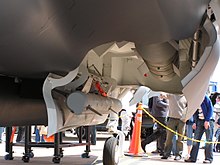
Weapons bay on a mock-up of the F-35
Internally (current planned weapons for integration), up to two air-to-air missiles and two air-to-air or air-to-ground weapons (up to two 2,000 lb (910 kg) bombs in A and C models (BRU-68); Lockheed Martin have suggested a Block 5 version will be fitted with six internal air-to-air weapons.[91] Two 1,000 lb (450 kg) bombs in the B model (BRU-67)) can be carried in the bomb bays.[92][93] These could be AIM-120 AMRAAM, AIM-132 ASRAAM, the Joint Direct Attack Munition (JDAM) – up to 2,000 lb (910 kg), the Joint Stand off Weapon (JSOW), Small Diameter Bombs (SDB) – a maximum of four in each bay (three per bay in F-35B,[94] or four GBU-53/B in each bay for all F-35 variants.[95]), the Brimstone anti-armor missiles, and Cluster Munitions (WCMD).[93] The MBDA Meteor air-to-air missile is currently being adapted to fit four internally in the missile spots and may be integrated into the F-35. A modified Meteor design with smaller tailfins for the F-35 was revealed in September 2010.[96] The United Kingdom had originally planned to put up to four AIM-132 ASRAAM internally but this has been changed to carry 2 internal and 2 external ASRAAMs.[97] The external ASRAAMs will add only an insignificant amount to the F-35's radar cross section and will allow attacks to slightly beyond visual range without using radar that might alert the target.[98]
At the expense of being more detectable by radar, many more missiles, bombs and fuel tanks can be attached on four wing pylons and two near wingtip positions. The two wingtip locations can only carry AIM-9X Sidewinder. The other pylons can carry the AIM-120 AMRAAM, Storm Shadow, AGM-158 Joint Air to Surface Stand-off Missile (JASSM) cruise missiles, guided bombs, 480-gallon and 600-gallon fuel tanks.[99] An air-to-air load of eight AIM-120s and two AIM-9s is conceivable using internal and external weapons stations, as well as a configuration of six 2,000 lb (910 kg) bombs, two AIM-120s and two AIM-9s.[93][100] With its payload capability, the F-35 can carry more weapons payload than the legacy fighters it is to replace as well as the F-22 Raptor.[101] Solid-state lasers were being developed as optional weapons for the F-35 as of 2002.[102][103][104]
While the F-35 will take on the Wild Weasel mission, it will lack the ability to carry an anti-radiation missile internally (and therefore stealthily) until the JDRADM is fielded in 2025.[105]
Norway and Australia are funding a program to adapt the Naval Strike Missile (NSM) to fit the internal bays of the F-35. This will be a multi-role version, named the Joint Strike Missile (JSM), and will be the only cruise missile to fit the internal bays. Studies have shown that the F-35 would be able to carry two of these internally, while four additional missiles could be carried externally. The missile has an expected range in excess of 150 nautical miles.[106]
Stealth
The F-35 has been designed to have a low radar cross section primarily due to low observable materials used in construction, including fibre-mat.[61] Unlike the previous generation of fighters, the F-35 was designed with a shape for low-observable characteristics.[107]The Teen Series of fighters (F-15, F-16, F/A-18) were notable for always carrying large external fuel tanks, but in order to avoid negating its stealth characteristics the F-35 must fly most missions without external fuel tanks. Unlike the F-16 and F/A-18, the F-35 lacks leading edge extensions and instead uses stealth-friendly chines for vortex lift in the same fashion as the SR-71 Blackbird.[90] The small bumps just forward of the engine air intakes form part of the diverterless supersonic inlet (DSI) which is a simpler, lighter means to ensure high-quality airflow to the engine over a wide range of conditions. These inlets also crucially improve the aircraft's low-observable characteristics.[108]
In spite of being smaller than the F-22, the F-35 has a larger radar cross section. It is said to be roughly equal to a metal golf ball rather than the F-22's metal marble.[109] The F-22 was designed to be difficult to detect by all types of radars and from all directions.[110] The F-35 on the other hand manifests its lowest radar signature from the frontal aspect because of compromises in design. Its surfaces are shaped to best defeat radars operating in the X and upper S band, which are typically found in fighters, surface-to-air missiles and their tracking radars, although the aircraft would be easier to detect using other radar frequencies.[110]
Ground crews require Repair Verification Radar (RVR) test sets in order to verify the RCS of the aircraft after performing repairs, which was not a concern for previous generations of non-stealth fighters.[111][112]
Cockpit
The F-35 features a full-panel-width "panoramic cockpit display" (PCD) glass cockpit, with dimensions of 20 by 8 inches (50 by 20 centimeters).[113] A cockpit speech-recognition system (Direct Voice Input) provided by Adacel is planned to improve the pilot's ability to operate the aircraft over the current-generation interface. The F-35 will be the first US operational fixed-wing aircraft to use this system, although similar systems have been used in AV-8B and trialled in previous US jets, particularly the F-16 VISTA.[114]A helmet-mounted display system (HMDS) will be fitted to all models of the F-35. A helmet-mounted cueing system is already in service with the F-15s, F-16s and F/A-18s.[115] While some fighters have offered HMDS along with a head up display (HUD), this will be the first time in several decades that a front line tactical jet fighter has been designed without a HUD.[116] The F-35 is equipped with a right-hand side stick controller in a standard Lockheed Martin HOTAS configuration.
The Martin-Baker US16E ejection seat is used in all F-35 variants.[117] The US16E seat design balances major performance requirements, including safe-terrain-clearance limits, pilot-load limits, and pilot size. It uses a twin-catapult system that is housed in side rails.[118]
Sensors and avionics
The F-35's sensor and communications suite is intended to facilitate situational awareness, command-and-control and network-centric warfare capability.[119][120] The main sensor on board the F-35 is its AN/APG-81 AESA-radar, designed by Northrop Grumman Electronic Systems.[121] It is augmented by the Electro-Optical Targeting System (EOTS) mounted under the nose of the aircraft, designed by Lockheed Martin.[122] This gives the same capabilities as the Lockheed Martin Sniper XR while avoiding making the plane more easily detectable.[123][124]Six additional passive infrared sensors are distributed over the aircraft as part of Northrop Grumman's AN/AAQ-37 distributed aperture system (DAS),[125] which acts as a missile warning system, reports missile launch locations, detects and tracks approaching aircraft spherically around the F-35, and replaces traditional night vision goggles for night operations and navigation. All DAS functions are performed simultaneously, in every direction, at all times. The F-35's AN/ASQ-239 (Barracuda) Electronic Warfare systems are designed by BAE Systems and include Northrop Grumman components.[126] The communications, navigation and identification (CNI) suite is designed by Northrop Grumman and includes the Multifunction Advanced Data Link (MADL). The F-35 will be the first jet fighter that has sensor fusion that combines both radio frequency and IR tracking for continuous target detection and identification in all directions which is shared via MADL to other platforms without compromising low observability.[56]
The F-35 has been designed with synergy between sensors as a specific requirement, with the "senses" of the aircraft expected to provide a more cohesive picture of the reality around it, and be available in principle for use in any possible way, and any possible combination with one another. All of the sensors feed directly into the main processors to support the entire mission of the aircraft. For example the AN/APG-81 functions not just as a multi-mode radar, but also as part of the aircraft's electronic warfare system.[127]
Unlike previous aircraft, such as the F-22, all software for the F-35 is written in C++ for faster code development. The Integrity DO-178B real-time operating system (RTOS) from Green Hills Software runs on COTS Freescale PowerPC processors.[128] The final Block 3 software for the F-35 is planned to have 8.6 million lines of software code.[129] The scale of the program has led to a software crisis as officials continue to discover that additional software needs to be written.[130] General Norton Schwartz has said that the software is the biggest factor that might delay the USAF's initial operational capability which is now scheduled for April 2016.[131] Michael Gilmore, Director of Operational Test & Evaluation, has written that, "the F-35 mission systems software development and test is tending towards familiar historical patterns of extended development, discovery in flight test, and deferrals to later increments."[132]
The F-35's electronic warfare systems are intended to detect hostile aircraft first, which can then be scanned with the electro-optical system and action taken to engage or evade the opponent before the F-35 is detected.[127]
The USAF has expressed interest in upgrading the F-22 fleet with F-35 style advanced sensors, but has yet to budget any funds for this.[133]
The CATbird avionics testbed for the F-35 program has proved capable of detecting and jamming F-22 radars.[134]
Helmet-Mounted Display System
The F-35 need not be physically pointing at its target for weapons to be successful.[93][135] This is possible because of sensors that can track and target a nearby aircraft from any orientation, provide the information to the pilot through his helmet (and therefore visible no matter which way they are looking), and provide the seeker-head of a missile with sufficient information. Recent missile types provide a much greater ability to pursue a target regardless of the launch orientation, called "High Off-Boresight" capability, although the speed and direction in which the munition is launched must physically speaking nonetheless affect the chance of success. Sensors use combined radio frequency and infra red (SAIRST) to continually track nearby aircraft while the pilot's helmet-mounted display system (HMDS) displays and selects targets. The helmet system replaces the display suite-mounted head-up display used in earlier fighters.The F-35's systems provide the edge in the "observe, orient, decide, and act" OODA loop; stealth and advanced sensors aid in observation (while being difficult to observe), automated target tracking helps in orientation, sensor fusion simplifies decision making, and the aircraft's controls allow action against targets without having to look away from them.[136][N 4]
The problems with the current Vision Systems International helmet mounted display lead Lockheed Martin to issue a draft specification for proposals for an alternative on 1 March 2011.[137]
RAND war games
In 2008 it was reported that RAND Corporation conducted simulated war games in which Russian Sukhoi Su-35 fighters apparently defeated the F-35.[91] As a result of these media reports, then Australian defence minister Joel Fitzgibbon requested a formal briefing from the Australian Department of Defence on the simulation. This briefing stated that the reports of the simulation were inaccurate and did not actually compare the F-35's flight performance against other aircraft.[138]The Pentagon and Lockheed Martin added that these simulations did not address air-to-air combat.[139][140] A Lockheed Martin press-release points to USAF simulations regarding the F-35's air-to-air performance against potential adversaries described as "4th generation" fighters, in which it claims the F-35 is "400 percent" more effective. Major General Charles R. Davis, USAF, the F-35 program executive officer, has stated that the "F-35 enjoys a significant Combat Loss Exchange Ratio advantage over the current and future air-to-air threats, to include Sukhois".[140] The nature of the simulations, and the terms upon which the "400 percent" figure have been derived remains unclear. Regarding the original plan to fit the F-35 with only two air-to-air missiles, Major Richard Koch, chief of USAF Air Combat Command’s advanced air dominance branch is reported to have said that "I wake up in a cold sweat at the thought of the F-35 going in with only two air-dominance weapons."[141]
Concerns over performance and safety
Andrew Krepinevich has questioned the reliance on "short range" aircraft like the F-35 or F-22 to 'manage' China in a future conflict and has suggested reducing the number of F-35s ordered in favor of a longer range platform like the Next-Generation Bomber, but Michael Wynne, then United States Secretary of the Air Force rejected this plan of action in 2007.[142][143][144] However in 2011, the Center for Strategic and Budgetary Assessments (CSBA) pointed to the restructuring of the F-35 program and the return of the bomber project as a sign of their effectiveness, while Rebecca Grant said that the restructuring was a "vote of confidence" in the F-35 and "there is no other stealthy, survivable new fighter program out there".[145]Former RAND author John Stillion has written of the F-35A's air-to-air combat performance that it “can’t turn, can’t climb, can’t run”, but Lockheed Martin test pilot Jon Beesley has countered that in an air-to-air configuration the F-35 has almost as much thrust as weight and a flight control system that allows it to be fully maneuverable even at a 50-degree angle of attack.[146]
Chen Hu, editor-in-chief of World Military Affairs magazine has said that the F-35 is too costly because it attempts to provide the capabilities needed for all three American services in a common airframe.[147] Dutch news program NOVA show interviewed US defense specialist Winslow T. Wheeler and aircraft designer Pierre Sprey who called the F-35 "heavy and sluggish" as well as having a "pitifully small load for all that money", and went on to criticize the value for money of the stealth measures as well as lacking fire safety measures. His final conclusion was that any air force would be better off maintaining its fleets of F-16s and F/A-18s compared to buying into the F-35 program.[148] Lockheed spokesman John Kent has said that the missing fire-suppression systems would have offered "very small" improvements to survivability.[149]
In the context of selling F-35s to Israel to match the F-15s that will be sold to Saudi Arabia, a senior U.S. defense official was quoted as saying that the F-35 will be "the most stealthy, sophisticated and lethal tactical fighter in the sky," and added "Quite simply, the F-15 will be no match for the F-35."[150] After piloting the plane, RAF Squadron Leader Steve Long said that, over its existing planes, the F-35 will give "the RAF and Navy a quantum leap in airborne capability."[151]
Consultant to Lockheed Martin Loren B. Thompson has said that the "electronic edge F-35 enjoys over every other tactical aircraft in the world may prove to be more important in future missions than maneuverability".[152]
In 2010, Canadian politicians raised the issue of the safety of the F-35's reliance on a single engine (as opposed to a twin-engine configuration, which provides a backup in case of an engine failure). Canada had previous experience with a high-accident rate with the single-engine F-104 with many accidents related to engine failures. Defence Minister Peter MacKay, when asked what would happen if the F-35’s single engine fails in the Far North, stated "It won’t".[153]
Manufacturing responsibilities
Lockheed Martin Aeronautics is the prime contractor and performs aircraft final assembly, overall system integration, mission system, and provides forward fuselage, wings and flight controls system. Northrop Grumman provides Active Electronically Scanned Array (AESA) radar, electro-optical Distributed Aperture System (DAS), Communications, Navigation, Identification (CNI), center fuselage, weapons bay, and arrestor gear. BAE Systems provides aft fuselage and empennages, horizontal and vertical tails, crew life support and escape systems, Electronic warfare systems, fuel system, and Flight Control Software (FCS1). Alenia will perform final assembly for Italy and, according to an Alenia executive, assembly of all European aircraft with the exception of Turkey and the United Kingdom.[125][154] As an international program, countries that help build the F-35 will form a competitive marketplace where parts and maintenance contracts are traded.[155] On 24 November 2009, Jon Schreiber[who?] said that the United States will not share the software code for the F-35 with its Allies.[156] The F-35 program has seen a great deal of investment in automated production facilities. For example, Handling Specialty produced the wing assembly platforms for Lockheed Martin.[157]Next Generation Jammer
The United States Marine Corps is considering replacing their Northrop Grumman EA-6B Prowler electronic attack aircraft with F-35s that have stealthy jammer pods attached.[158] On 30 September 2008, the United States Navy outlined the basic requirements of the NGJ and stated that the design must be modular and open.[159] The Navy has selected four companies to submit designs for the Next Generation Jammer.[160] The NGJ will also have cyber attack capabilities where the AESA radar is used to insert tailored data streams into remote systems.[161][162] The ITT-Boeing design for the NGJ includes six AESA arrays for all around coverage.[163][164] The team has been awarded a $42 million contract to develop their design based on ITT's experience with broadband electronically steerable antenna arrays.[165] At the same time contracts were also awarded to Raytheon, Northrop Grumman and BAE Systems.[166]Operational history
Testing
The first F-35A (designated AA-1) was rolled out in Fort Worth, Texas on 19 February 2006. The aircraft underwent extensive ground testing at Naval Air Station Joint Reserve Base Fort Worth in late 2006. In September 2006 the first engine run of the F135 afterburner turbofan in an airframe and tests were completed; the first time that the F-35 was completely functional on its own power systems.[167] On 15 December 2006, the F-35A completed its maiden flight.[1] A modified Boeing 737-300, the Lockheed CATBird is used as an avionic test bed inside of which are racks holding all of F-35's avionics, as well as a complete F-35.[91]On 31 January 2008 at Fort Worth, Texas, Lt Col James "Flipper" Kromberg of the U.S. Air Force became the first military service pilot to evaluate the F-35, taking the aircraft through a series of maneuvers on its 26th flight. F-35 AA-1, on its 34th test flight, began aerial refueling testing in March 2008.[168] Another milestone was reached on 13 November 2008, when the AA-1 flew at supersonic speeds for the first time, reaching Mach 1.05 at 30,000 ft (9,144 m) making four transitions through the sound barrier, for a total of eight minutes of supersonic flight.[169]
The first F-35B (designated BF-1) made its maiden flight on 11 June 2008. The flight, which featured a conventional takeoff, was piloted by BAE Systems' test pilot Graham Tomlinson. The BF-1 is the second of 19 System Development and Demonstration (SDD) F-35s, and the first to use new weight-optimized design features that will apply to all future F-35s.[170] Testing of the STOVL propulsion system in flight began on 7 January 2010. The STOVL system was used for 14 minutes of the 48 minute test flight while the aircraft slowed from 210 knots (390 km/h) to 180 knots (330 km/h).[171][172] The F-35B's first hover (full stop in mid-air) happened on 17 March 2010, followed by a STOVL landing,[173] and on 18 March 2010 the first vertical landing was performed.[174] During a test flight on 10 June 2010, the F-35B became the second STOVL aircraft to achieve supersonic speeds,[175] the first being its ancestor, the X-35B, which achieved the same feat on 20 July 2001.[176] In January 2011, Lockheed Martin reported it had solved a problem with the aluminum bulkhead used only on the F-35B which had cracked during ground testing.[177]
Although many of the initial flight test targets have been accomplished, the F-35 testing program completed "just under 100 sorties and about as many hours in 2.5 years" by June 2009 and was falling significantly behind schedule.[178] A 2008 Pentagon Joint Estimate Team (JET I) estimated that the program was two years behind the latest public schedule, and a 2009 Joint Estimate Team (JET II) revised that estimate to predict a 30-month delay.[179] Due to those delays in the testing program, production numbers will be reduced by 122 aircraft through 2015 in order to provide additional funds for development.[180] Those additional funds will add $2.8 billion to the development funds and internal memos suggest that the official timeline will be extended by 13 months (not the 30 months the JET II team predicted the slip would be).[179] The success of the Joint Estimate Team has led Ashton Carter to call for more such teams for other poorly performing Pentagon projects.[181]
Nearly 30 percent of all the test flights have required more than routine maintenance to get the aircraft flyable again.[182] As of March 2010, the F-35 program had used a million more man-hours than predicted and flight testing is expected to result in further design changes.[183] The United States Navy has projected that lifecycle costs over a fleet life of 65 years for all of the American F-35s will be $442 billion higher than the U.S. Air Force has projected.[184] The delay in the F-35 program is expected to lead to a shortfall of around 100 jet fighters in the Navy/Marines team. Given careful management, service life extension of the Marines' legacy F/A-18s, and more burdens placed on Navy fighters, it may be possible to reduce this shortfall.[3] The F-35C carrier variant's maiden flight took place on 7 June 2010, also at NAS Fort Worth JRB. The 57 minute flight was executed by Lockheed test pilot Jeff "Slim" Knowles, who was the chief test pilot for the F-117 program.[185] A total of 11 U.S. Air Force F-35s are to arrive in Fiscal Year 2011.[186]
International participation and procurement
Main article: Lockheed Martin F-35 Lightning II procurement
While the United States is the primary customer and financial backer, the United Kingdom, Italy, the Netherlands, Canada, Turkey, Australia, Norway and Denmark have agreed to contribute US$4.375 billion toward the development costs of the program.[9] Total development costs are estimated at more than US$40 billion (underwritten largely by the United States), while the purchase of an estimated 2,400 planes is expected to cost an additional US$200 billion.[187] The nine major partner nations plan to acquire over 3,100 F-35s through 2035.[188] The F-35 is expected to lift the American share of the $16 billion fighter aircraft market from 58 percent to more than 67 percent as European competitors fall further behind.[189]There are three levels of international participation. The levels generally reflect the financial stake in the program, the amount of technology transfer and subcontracts open for bid by national companies, and the order in which countries can obtain production aircraft. The United Kingdom is the sole "Level 1" partner, contributing US$2.5 billion, which was about 10% of the planned development costs[190] under the 1995 Memorandum of Understanding that brought the UK into the project.[191] Level 2 partners are Italy, which is contributing US$1 billion; and the Netherlands, US$800 million. Level 3 partners are Turkey, US$195 million; Canada, US$160 million; Australia, US$144 million; Norway, US$122 million and Denmark, US$110 million. Israel and Singapore have joined as Security Cooperative Participants (SCP).[192][193][194]
Variants
The F-35 is being built in three different main versions to suit various combat missions. A fourth variant, the F-35I is an export version for Israel.F-35A
The F-35A is the conventional takeoff and landing (CTOL) variant intended for the US Air Force and other air forces. It is the smallest, lightest F-35 version and is the only variant equipped with an internal cannon, the GAU-22/A. This 25 mm cannon is a development of the GAU-12 carried by the USMC's AV-8B Harrier II. It is designed for increased effectiveness against ground targets compared to the 20 mm M61 Vulcan cannon carried by other USAF fighters.The F-35A is expected to match the F-16 in maneuverability and instantaneous and sustained high-g performance, and outperform it in stealth, payload, range on internal fuel, avionics, operational effectiveness, supportability, and survivability.[195] It is expected to match a F-16 that is carrying the usual external fuel tank in acceleration performance.[196] It also has an internal laser designator and infrared sensors, equivalent to the Sniper XR pod carried by the F-16, but built in to reduce radar cross section.
The A variant is primarily intended to begin replacing the USAF's F-16 Fighting Falcon in 2013, and replace the A-10 Thunderbolt II starting in 2028.[197][198]
F-35B
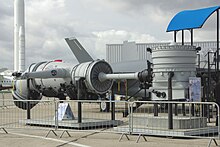
The Pratt & Whitney F135 engine with lift fan, roll posts, and rear vectoring nozzle, as designed for the F-35B, at the Paris Air Show, 2007
Unlike the other variants, because it can land vertically the F-35B has no landing hook. The "STOVL/HOOK" button in the cockpit initiates conversion instead of dropping the hook.[203] The F-35B sends jet thrust directly downwards during vertical takeoffs and landing and the nozzle is being redesigned to spread the output out in an oval rather than a small circle so as to limit damage to asphalt and ship decks.[204]
The United States Marine Corps plans to purchase 340 F-35Bs,[205] to replace all current inventories of the F/A-18 Hornet (A, B, C and D-models), and AV-8B Harrier II in the fighter, and attack roles.[206]
The Royal Air Force and Royal Navy had planned to use the F-35B to replace their Harrier GR9s. One of the Royal Navy requirements was that the F-35B design should have a Shipborne Rolling and Vertical Landing (SRVL) mode so that wing lift could be added to powered lift to increase the maximum landing weight of carried weapons.[207][208] This method of landing is slower than wire arrested landing and could disrupt regular carrier operations,[209] as the landing method uses the same pattern of approach as wire arrested. With SRVL, the aircraft is able to "bring back" 2 ⨉ 1K JDAM, 2 ⨉ AIM-120 and reserve fuel.[210] However, in October 2010, Prime Minister David Cameron announced that the UK would change their F-35 order to the CATOBAR F-35C variant.[211]
Commandant of the Marine Corps, General James Amos has said that, in spite of its increasing costs and schedule delays, there is no plan B to substitute for the F-35B.[212] The F-35B is larger than the aircraft it replaces, which required the USS America (LHA-6) to be designed without needed well deck capabilities.[213] The United States Navy has argued that USMC squadrons that operate from supercarriers should use the F-35C instead of the "suboptimal" F-35B.[214] United States Secretary of the Navy, Ray Mabus said in February 2011 that Marines flying from the carriers will use the F-35C.[215]
On 6 January 2011, Gates said that the 2012 budget would call for a two year pause in F-35B production during which the aircraft may be redesigned, or canceled if unsuccessful. Gates stated, "If we cannot fix this variant during this time frame, and get it back on track in terms of performance, cost and schedule, then I believe it should be canceled."[216][217][218]
Lockheed Martin executive vice president Tom Burbage and former Pentagon director of operational testing Tom Christie have said that most of the delays in the total program have been due to issues with the F-35B, which forced massive redesigns on the other versions.[219]
F-35C
The F-35C carrier variant features larger wings with foldable wingtip sections, larger wing and tail control surfaces for improved low-speed control, stronger landing gear for the stresses of carrier landings, and a stronger tailhook for use with carrier arrestor cables. The larger wing area allows for decreased landing speed while increasing both range and payload. With twice the range on internal fuel as the F/A-18C Hornet, the F-35C achieves much the same goal as the F/A-18E/F Super Hornet.The United States Navy will use the F-35C carrier variant. It intends to buy 480 F-35Cs to replace the F/A-18A, B, C, and D Hornets. The F-35C will also serve as a low-observable complement to the Super Hornet.[220] On 27 June 2007, the carrier variant completed its Air System Critical Design Review (CDR). This allows the first two functional prototype F-35C units to be produced.[221] The C variant is expected to be available beginning in 2014.[222] The first F-35C was rolled out on 29 July 2009.[223] On 6 November 2010, the first F-35C arrived at Naval Air Station Patuxent River.[224]
In October 2010, the United Kingdom decided to change its F-35B order to the F-35C, which will be used for both land and naval operations.[225] The total number of F-35C aircraft to be procured has not been announced. However, it will be less than the 150 originally planned.[225] The Royal Navy's new Queen Elizabeth class aircraft carriers are large enough to support non-STOVL operations and as a result, at least HMS Queen Elizabeth will have catapults and arrestor cables installed to allow F-35C and Allied naval aircraft operations.[211][225] The carrier will typically carry 12 F-35Cs with the ability to deploy up to 36.[225][226] The UK Strategic Defence & Security Review found that the F-35C's greater endurance in the air meant that fewer aircraft would be needed and that the F-35C has a 25 percent lower lifetime cost than the F-35B.[227]
F-35I
Main article: Lockheed Martin F-35 Lightning II procurement#Israel
F-35A with Israeli modifications. A senior Israel air force official stated "the aircraft will be designated F-35I, as there will be unique Israeli features installed in them". The United States will not allow for the integration of Israel's own electronic warfare systems into the aircraft’s built-in electronic suite. However, a plug-and-play feature added to the main computer will allow for use of Israeli electronics in an add-on fashion. Israel will be able to fit its own external jamming pod and plans to install its own air-to-air missiles and guided bombs in the F-35’s internal weapon bays.[228]Specifications (F-35A)
| F-35B Lightning II cutaway illustration | |
|---|---|
| Hi-res cutaway of F-35B Lightning II STOVL by Flight Global, 2006. | |
Data from Lockheed Martin specifications,[57][229][230] F-35 Program brief,[93] F-35 JSF Statistics[88]
General characteristics- Crew: 1
- Length: 51.4 ft (15.67 m)
- Wingspan: 35 ft[N 5] (10.7 m)
- Height: 14.2 ft[N 6] (4.33 m)
- Wing area: 460 ft²[93] (42.7 m²)
- Empty weight: 29,300 lb (13,300 kg)
- Loaded weight: 49,540 lb[56][N 7][231] (22,470 kg)
- Max takeoff weight: 70,000 lb[N 8] (31,800 kg)
- Powerplant: 1× Pratt & Whitney F135 afterburning turbofan
- Internal fuel capacity: 18,480 lb (8,382 kg)[N 10]
- Maximum speed: Mach 1.6+[88] (1,200 mph, 1,930 km/h)
- Range: 1,200 nmi (2,220 km) on internal fuel
- Combat radius: over 590 nmi[N 11] (1,090 km) on internal fuel[234]
- Service ceiling: 60,000 ft[235] (18,288 m)
- Rate of climb: classified (not publicly available)
- Wing loading: 91.4 lb/ft² (446 kg/m²)
- Thrust/weight:
- With full fuel: 0.87
- With 50% fuel: 1.07
- g-Limits: 9 g[N 12]
- Guns: 1 × General Dynamics GAU-22/A Equalizer 25 mm (0.984 in) 4-barreled gatling cannon, internally mounted with 180 rounds[N 13][88]
- Hardpoints: 6 × external pylons on wings with a capacity of 15,000 lb (6,800 kg)[88][93] and 2 internal bays with 2 pylons each[93] for a total weapons payload of 18,000 lb (8,100 kg)[57] and provisions to carry combinations of:
- Missiles:
- Bombs:
- Mark 84, Mark 83 and Mark 82 GP bombs
- Mk.20 Rockeye II cluster bomb
- Wind Corrected Munitions Dispenser capable
- Paveway-series laser-guided bombs
- Small Diameter Bomb (SDB)
- JDAM-series
- B61 nuclear bomb[237]
- Missiles:
- Northrop Grumman Electronic Systems AN/APG-81 AESA radar
- Northrop Grumman Electronic Systems AN/AAQ-37 Distributed Aperture System (DAS) missile warning system
- BAE Systems AN/ASQ-239 (Barracuda) electronic warfare system
- Harris Corporation Multifunction Advanced Data Link (MADL) communication system
| F-35A CTOL | F-35B STOVL | F-35C Carrier version | |
|---|---|---|---|
| Length | 51.4 ft (15.7 m) | 51.3 ft (15.6 m) | 51.5 ft (15.7 m) |
| Wingspan | 35 ft (10.7 m) | 35 ft (10.7 m) | 43 ft (13.1 m) |
| Wing Area | 460 ft² (42.7 m²) | 460 ft² (42.7 m²) | 668 ft² (62.1 m²) |
| Empty weight | 29,300 lb (13,300 kg) | 32,000 lb (14,500 kg) | 34,800 lb (15,800 kg) |
| Internal fuel | 18,500 lb (8,390 kg) | 13,300 lb (6,030 kg) | 19,600 lb (8,890 kg) |
| Max takeoff weight | 70,000 lb (31,800 kg) | 60,000 lb (27,000 kg) | 70,000 lb (31,800 kg) |
| Range | 1,200 nmi (2,220 km) | 900 nmi (1,670 km) | 1,400 nmi (2,520 km) |
| Combat radius on internal fuel | 590 nmi (1,090 km) | 450 nmi (833 km) | 640 nmi (1,185 km) |
| Thrust/weight full fuel 50% fuel | 0.87 1.07 | 0.90 1.04 | 0.75 0.91 |
 Unknown
Unknown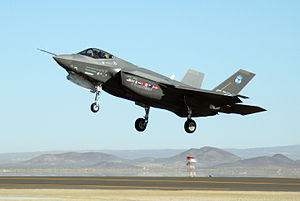

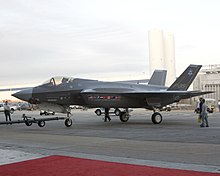
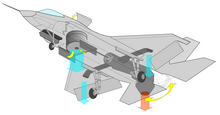
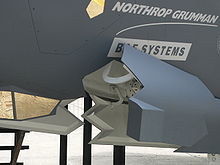


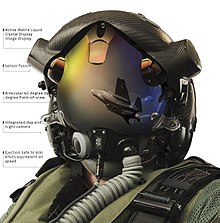
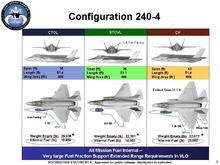












0 komentar:
Post a Comment